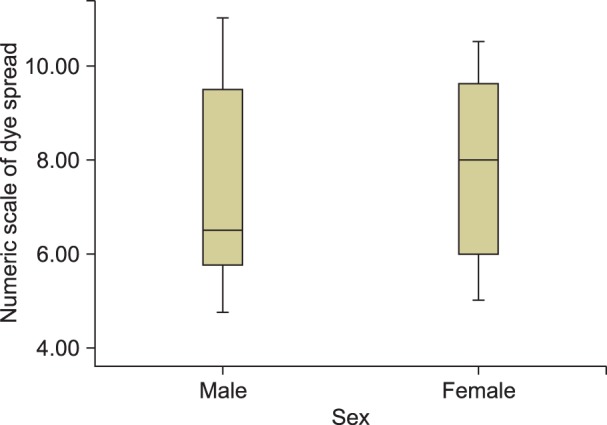1. Boas RA. Sympathetic nerve blocks: in search of a role. Reg Anesth Pain Med. 1998; 23:292–305. PMID:
9613543.
2. Stanton-Hicks M. Complications of sympathetic blocks for extremity pain. Tech Reg Anesth Pain Manag. 2007; 11:148–151.

3. Datta S, Pai U. Paradiscal extraforaminal technique for lumbar sympathetic block: report of a proposed new technique utilizing a cadaver study. Pain Physician. 2004; 7:53–57. PMID:
16868611.
4. Hong JH, Oh MJ. Comparison of multilevel with single level injection during lumbar sympathetic ganglion block: efficacy of sympatholysis and incidence of psoas muscle injection. Korean J Pain. 2010; 23:131–136. PMID:
20556215.

5. Middleton WJ, Chan VW. Lumbar sympathetic block: a review of complications. Tech Reg Anesth Pain Manag. 1998; 2:137–146.

6. Kim WH, Kim SK, Lee CJ, Kim TH, Sim WS. Determination of adequate entry angle of lumbar sympathetic ganglion block in Korean. Korean J Pain. 2010; 23:11–17. PMID:
20552067.

7. Umeda S, Arai T, Hatano Y, Mori K, Hoshino K. Cadaver anatomic analysis of the best site for chemical lumbar sympathectomy. Anesth Analg. 1987; 66:643–646. PMID:
3605673.

8. Rocco AG, Palombi D, Raeke D. Anatomy of the lumbar sympathetic chain. Reg Anesth. 1995; 20:13–19. PMID:
7727322.
9. Stevens RA, Stotz A, Kao TC, Powar M, Burgess S, Kleinman B. The relative increase in skin temperature after stellate ganglion block is predictive of a complete sympathectomy of the hand. Reg Anesth Pain Med. 1998; 23:266–270. PMID:
9613538.

10. Kim HJ, Lee CO, Shin YS, Lee YW. Appropriate block level in neurolytic lumbar sympathetic ganglion block. J Korean Pain Soc. 2001; 14:199–206.
11. Sayson SC, Ramamurthy S, Hoffman J. Incidence of genitofemoral nerve block during lumbar sympathetic block: comparison of two lumbar injection sites. Reg Anesth. 1997; 22:569–574. PMID:
9425975.
12. Kim YC, Bahk JH, Lee SC, Lee YW. Infrared thermographic imaging in the assessment of successful block on lumbar sympathetic ganglion. Yonsei Med J. 2003; 44:119–124. PMID:
12619184.

13. Tran KM, Frank SM, Raja SN, El-Rahmany HK, Kim LJ, Vu B. Lumbar sympathetic block for sympathetically maintained pain: changes in cutaneous temperatures and pain perception. Anesth Analg. 2000; 90:1396–1401. PMID:
10825327.

14. Gofeld M, Faclier G. Radiofrequency denervation of the lumbar zygapophysial joints--targeting the best practice. Pain Med. 2008; 9:204–211. PMID:
18298703.

15. Hatangdi VS, Boas RA. Lumbar sympathectomy: a single needle technique. Br J Anaesth. 1985; 57:285–289. PMID:
3978011.

16. Waldman SD. Atlas of interventional pain management. 3rd ed. Philadelphia (PA): WB Saunders;2004. p. 1314–1321.
17. Feigl GC, Dreu M, Ulz H, Breschan C, Maier C, Likar R. Susceptibility of the genitofemoral and lateral femoral cutaneous nerves to complications from lumbar sympathetic blocks: is there a morphological reason? Br J Anaesth. 2014; 112:1098–1104. PMID:
24554547.

18. Hong JH, Kim AR, Lee MY, Kim YC, Oh MJ. A prospective evaluation of psoas muscle and intravascular injection in lumbar sympathetic ganglion block. Anesth Analg. 2010; 111:802–807. PMID:
20686003.

19. Koizuka S, Saito S, Obata H, Tobe M, Koyama Y, Takahashi A. Anatomic analysis of computed tomography images obtained during fluoroscopic computed tomography-guided percutaneous lumbar sympathectomy. J Anesth. 2008; 22:373–377. PMID:
19011775.

20. Kuzmarov IW, MacIsaac SG, Sioufi J, DeDomenico I. Iatrogenic ureteral injury secondary to lumbar sympathetic ganglion blockade. Urology. 1980; 16:617–619. PMID:
7445314.

21. Ryttov N, Boe S, Nielsen H, Jacobsen J. Necrosis of ureter as a complication to chemical lumbar sympathectomy. Report of a case. Acta Chir Scand. 1981; 147:79–80. PMID:
7234281.
22. Baxter AD, O'Kafo BA. Ejaculatory failure after chemical sympathectomy. Anesth Analg. 1984; 63:770–771. PMID:
6540536.

23. Chung YJ, Choi JB, Lee YW. Radiofrequency lumbar sympatholysis: comparison with neurolytic alcohol block. J Korean Pain Soc. 2004; 17:42–46.

24. Koizuka S, Saito S, Masuoka S, Nakajima K, Koyama Y. Location of major vessels in prone-positioned patients undergoing percutaneous lumbar sympathectomy. Neuroradiology. 2012; 54:1127–1131. PMID:
22349565.

25. Bateman DK, Millhouse PW, Shahi N, Kadam AB, Maltenfort MG, Koerner JD, et al. Anterior lumbar spine surgery: a systematic review and meta-analysis of associated complications. Spine J. 2015; 15:1118–1132. PMID:
25728552.

26. Rocco AG. Radiofrequency lumbar sympatholysis. The evolution of a technique for managing sympathetically maintained pain. Reg Anesth. 1995; 20:3–12. PMID:
7727325.
27. Racz GB, Stanton-Hicks M. Lumbar and thoracic sympathetic radiofrequency lesioning in complex regional pain syndrome. Pain Pract. 2002; 2:250–256. PMID:
17147739.

28. Kim SH, Moon DE, Park CM, Ryu KH, Seo KS, You SH. Thoracic spinal cord stimulation and radiofrequency thermocoagulation of lumbar sympathetic ganglion in a patient with complex regional pain syndrome in the lower extremity: a case report. Korean J Pain. 2005; 18:240–245.

29. Derby R, Lee CH. The efficacy of a two needle electrode technique in percutaneous radiofrequency rhizotomy: an investigational laboratory study in an animal model. Pain Physician. 2006; 9:207–213. PMID:
16886029.
30. Anfinsen OG, Kongsgaard E, Foerster A, Amlie JP, Aass H. Bipolar radiofrequency catheter ablation creates confluent lesions at larger interelectrode spacing than does unipolar ablation from two electrodes in the porcine heart. Eur Heart J. 1998; 19:1075–1084. PMID:
9717044.

31. Lee JH, Kim DW, Sim WS. Lumbar sympathetic radiofrequency thermocoagulation using bipolar probe in the hyperhidrosis patient: a case report. Korean J Pain. 2005; 18:92–95.

32. Boas RA. Sympathetic blocks in clinical practice. Int Anesthesiol Clin. 1978; 16:149–182. PMID:
84795.

33. Nagpal A, Eckmann M, Small S, Stevens S. Onset of spontaneous lower extremity pain after lumbar sympathetic block. Pain Physician. 2015; 18:E89–E91. PMID:
25675078.





 PDF
PDF Citation
Citation Print
Print






 XML Download
XML Download